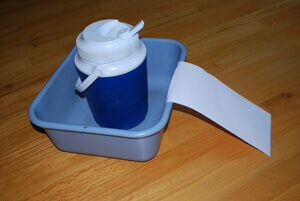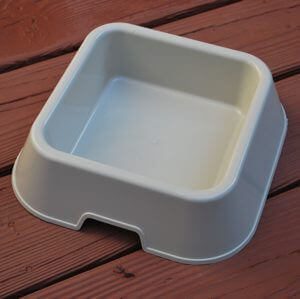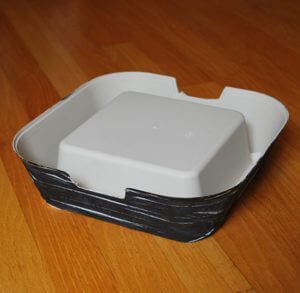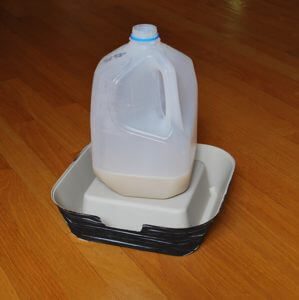
Bedbugs (Cimex lectularius) have posed a problem in the United States since colonial times. Colonists brought these pests with them on sailing ships.
Once here, these biting insects flourished until DDT became ubiquitous as a pesticide in the mid-20th century. Families would often put DDT around a bed to keep the bugs at bay. This insecticide nearly wiped out the infestations. Eventually, though, the creatures developed resistance to many insecticides.
Do You Have Bedbugs?
There has been a resurgence of bedbugs in apartments, homes and hotels. People often worry that their space has been invaded. That’s why many people have becomes interested in detecting bedbugs.
Do-It-Yourself Bedbug Trap to Find Them:
Some years ago, we wrote about a simple homemade bedbug detection system. (You can read more and see the pictures below.) It utilizes an upside-down dog food dish wrapped in black surgical tape and coated with nonstick spray. In the center is a gallon jug with water, sugar and yeast to produce the alluring (to bedbugs) scent of carbon dioxide. This do-it-yourself project was described in the Journal of Economic Entomology (Aug. 2013).
We heard from an entomologist regarding this project. He discouraged the use of nonstick spray (designed to keep the bedbugs from escaping the trap).
Here’s the alternative he suggested:
“Do not buy any fluon; it’s expensive and completely unnecessary! I would suggest a killing fluid in the bottom of the trough like soapy water or a little vegetable oil. Most people already have this on hand–and dead bugs don’t climb out of traps! Surgical tape is not required, just a surface that is rough so the insects can climb up the walls of the trap.”
An Earlier Version of a Bedbug Trap:
Q. You described a technique for determining whether you have bedbugs, but I am confused. Do you put the cooler in its plastic dish directly on top of the mattress? Does it have to be at night? Should the jug be upright or lying on its side?
I was in Africa and have been itching since my return. I do have small welts and don’t know what they are, so I am anxious to find out if my bed is infested.
A. Despite the name bedbug, these insects are not limited to the bed and can travel around the room. That’s why the “detector” developed by Rutgers scientists and described in Science News (Dec. 18, 2009) can be set up in a corner of the bedroom on the floor.
Here’s the technique: bedbugs locate people by sensing carbon dioxide, so to trick them you will offer them a source of carbon dioxide. Two pounds of dry ice in a third-gallon cooler (like a Coleman jug) with a flip-up spout will do that. With the spout slightly open, the gas leaks out slowly.

Place the cooler in a plastic pet-food dish and tape a piece of paper to the outside of the dish as a gangplank for the bedbugs to climb. Dusting the dish with talcum powder makes it hard for them to get out. Within 12 hours there should be bedbugs in the bowl if you have them in the room.
Making Your Own Bedbug Trap:
Q. I am getting ready to move into a new apartment but before I sign the lease I want to test for bedbugs. I read about a home-made trap using dry ice to generate carbon dioxide. It is my understanding that bedbugs are attracted to this gas.
I’m having trouble finding dry ice. Is there any other way to generate carbon dioxide in a trap?
A. Bedbugs have made a dramatic resurgence all around the world. The media got quite excited about this epidemic a few years ago. Headlines announced bedbugs in hotels and apartment buildings. The TV news loved this story and scared people so much that some were afraid to travel for fear they would bring home bedbugs.
There is no doubt that bedbugs are hard to detect and eradicate. We completely understand why you would want to test for bedbugs before signing a lease. The best method is to hire a certified dog-detector.
After a trip to Italy last summer we came home semi-convinced that we had brought bedbugs home with us despite taking precautions to wash all our clothes and keep luggage in the trunk of the car to roast for several days in the heat. When we kept waking up with bites the next morrning we decided to hire the beagles. Two amazing dogs scoured our home from top to bottom. They sniffed everywhere, and fortunately for us, did not find a single bedbug. Here is a picture of Sadie…one of two amazingly well-trained bedbug detectors.
Now, it is not inexpensive to hire trained dogs to scour your home for bedbugs. Plan on a couple of hundred dollars or more, depending upon the size of your home. In some places it may be even more pricey.
Our entomologist commenter warns:
“One thing to remember about using canine scent detection is that it only gives you a snapshot of bedbug activity at that particular time. So if a dog gives the ‘all-clear’ on Tuesday and then bugs get brought in on Thursday, you’ve just wasted a couple hundred dollars. Dogs are great for inspecting an entire apartment complex in one day but for the average house or an apartment I would recommend a cheap trap like the homemade one.
“Generally, everyone in a place with bedbugs gets bitten, but not everyone reacts. I personally do not react to BB bites, not even a red bump the next day. Spiders are rarely the cause of mysterious welts, as most species will only bite as a last resort. But they are regularly blamed as the cause for bites!
“The most important thing to do when dealing with bedbugs is to figure out how they are getting introduced (where do you go, what do you do, who comes over) and to take proper precautions to avoid the source when possible. If you do find bedbugs, I highly recommend calling a professional.”
Step-by-Step D-I-Y Bedbug Detector:
We tried following the instructions published in the Journal of Economic Entomology (Aug. 2013). Bedbugs use carbon dioxide to locate humans, which is why carbon dioxide can be used to lure them into a trap.
The researchers used the following formula:
– 2 tablespoons of baker’s yeast
– 10 tablespoons of table sugar
– 3 cups of warm water
Put the mixture in one gallon plastic milk container (with the lid off). Set it on top of an upside-down dog food dish.
Here it is right-side up.
This dish needs to have the outer edge wrapped in paper surgical tape that is colored black. The researchers say that bedbugs prefer black to white. We used fabric dye to color the white tape. The researchers used a black leather dye to accomplish this.
The scientists coated the inside lightly with a special nonstick product called Fluon from BioQuip (Insect-A-Slip). This keeps the bedbugs from escaping once they’re in the trap (very important!). (But do consider our entomologist’s much less expensive suggestion above!) Here is the trap with the yeast fermenting the sugar in the bottom of the milk container and sending out carbon dioxide vapors that are irresistible to bedbugs.
After the Bedbug Trap:
This trap is merely to tell if the space is infested. It will not trap an adequate number of bedbugs to get rid of them. For that, you need further steps.
Many people try to eradicate bedbugs with insecticides. That rarely works and could expose people to toxic chemicals. Professionals can use whole room or whole house heat (135-145 degrees F). They monitor and control temperatures carefully over several hours. This usually kills the bugs without leaving a chemical residue behind.
Once a treatment has been completed, bring back the dogs or set up your homemade trap to make sure you have succeeded in eliminating the bugs once and for all.
Share your own bedbug story below. You can also learn more about bedbugs from this JAMA Patient Page on the topic.
Citations
- Singh N et al, "Effect of trap design, chemical lure, carbon dioxide release rate, and source of carbon dioxide on efficacy of bed bug monitors." Journal of Economic Entomology, Aug. 2013. DOI: 10.1603/ec13075
- Milius S, "Do-it-yourself bed-bug detector." Science News, Dec. 18, 2009.





